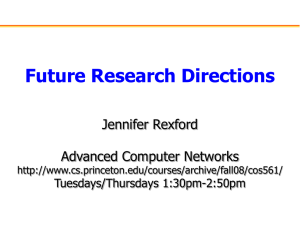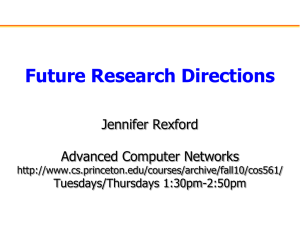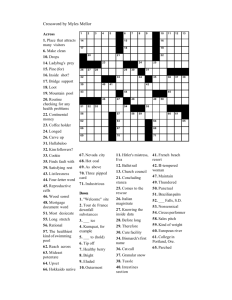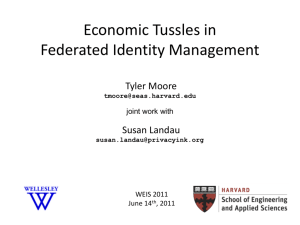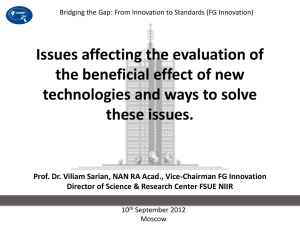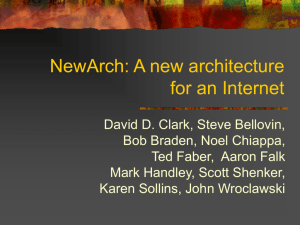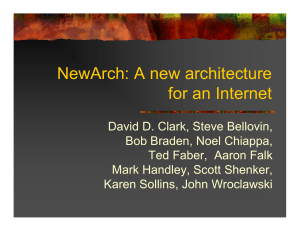Tussle in Cyberspace: Defining Tomorrow’s Internet Offense by Ahamed Mohammed
advertisement
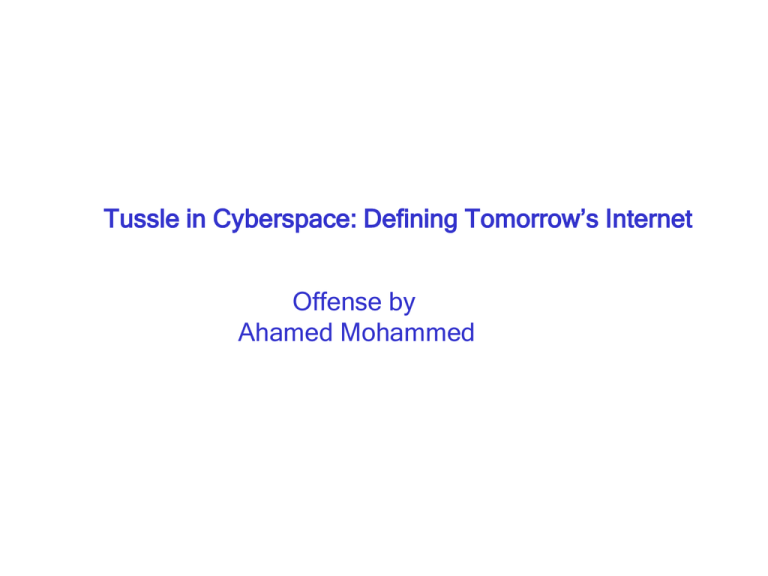
Tussle in Cyberspace: Defining Tomorrow’s Internet Offense by Ahamed Mohammed What I Agree With • Accommodating choices in design - Allows innovation - Allows a tussle to occur - Gives flexibility for designers and consumers Challenge: Flexibility increases complexity • Flexible designs will be complex • Applications should be written to deal with this complexity • Innovative applications come up….but slowly Challenge: Flexibility may decrease efficiency • A flexible design does not optimize for special cases ANTS (Active Networks) scheme: - Very flexible routing scheme - Packet contains code to execute - Forwarding node executes code - Execution comes up with next hop towards destination Inefficient: - Processing time dictates throughput..not bandwidth - Less than 20 Mbps throughput achieved Insecure: - Relies on java’s safety features Challenge: Designing for Outcomes • Paper says “Do not design so as to dictate the outcome” • How can a design proceed without a goal in mind? • Design of the internet based on “packet in – packet out” functionality..very simple and not designed for any outcome “..packets go in and come out and this is all happens in the network. This simple idea was powerful in the early days.. but there is much fear that it seems to be eroding..” So what went wrong to the outcome blind internet???? (self-contradicting) Challenge: Making a tussle space does not solve a problem • Paper does not talk about who wins in the tussle • Allowing a tussle to occur is not a solution Paper’s Example: DNS and Trademarks • Even if we separated trademark names from machine names, trademarks disputes will not disappear “…one could then try to design these latter mechanisms to try to duck the issue of trademark” The SMTP server example: “A user of mail may choose an SMTP server..An ISP might try to control that choice by redirecting packets..” Challenge: Lots of Choices Confuses Average User • Installing Windows is easier than installing Linux to an average user • Too much choice does not make a user happy • Confused about choices to make and their consequences • Only informed persons can make correct choices • Configuring and using simple applications becomes hard Papers response to this is unsatisfactory: “..we may see emergence of third parties that rate services (the online catalog of consumer reports) and parties that provide pre-configured software…” Challenge: Little Incentive to Providers of Choice • Providing more choices is costly • Popular choices will get cheaper (Economies of scale) • Users of less popular choices will need to pay more “One should be prepared to pay for what one uses or there is very little incentive for the provider to offer it.” Challenge: User empowerment through choices is not always good • Publicizing a lot of choice may expose internal structure • Makes it easier for the “bad guys” • As of now itself the intrusions and attacks are severe and difficult to deal with.. • Publicizing a good combination of choices will immediately decrease the edge you have on others..(copying) • Very little motivation to expose choice • If a server has good response time then publicizing it will lead to others also using it and overloading it Challenge: Santa’s universal point • The point of this paper is known already and acted upon • Transport layer provides choice: TCP/UDP • “IP-lock in” is addressed by DHCP and NAT’s • Loose source routing is addressed by overlay routing
